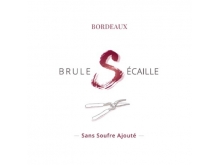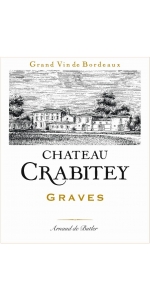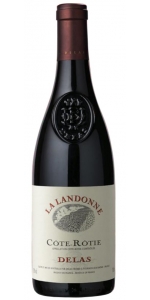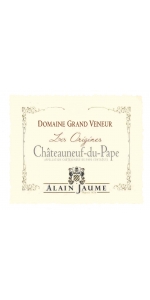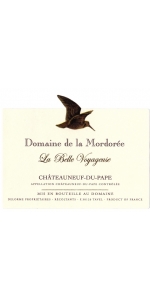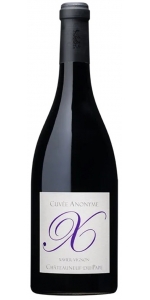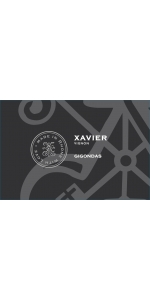Brulesecaille Rouge Sans Soufre Ajoute 2019
6 bottles with free shipping for: $144.00
12 bottles with free shipping for: $228.00
| BUY MORE! SAVE MORE! | ||||||||||||||||||||
|
| Country: | France |
| Region: | Bordeaux |
| Winery: | Vignobles Rodet Recapet |
| Grape Types: | Malbec Merlot |
| Vintage: | 2019 |
| Bottle Size: | 750 ml |
Brulesecaille Rouge Sans Soufre Ajoute is made from 50% Merlot and 50% Malbec.
Deep purple color, powerful nose of blackcurrant and floral as well. Full on the palate with soft and ripe tannins with a fresh aromatic return.
Aging potential 5 years.
Pairs with boeuf Bourguignon, grilled vegetables and strong cheeses.
Vignobles Rodet Recapet Estate Vignobles Rodet is owner of Château Brulesecaille and Château La Gravière in the Cotes de Bourg AOC. Jacques is a viticulture engineer (graduated from Bordeaux Science Agro) specialized in Nature Protection and focuses viticulture. Guillaume (graduated from DUAD Bordeaux) oversees vinification operations in the cellar. Jacques believes in using more natural methods to encourage ripening; he utilizes canopy mangement techniques, removes leaves and thins bunches as necessary. In September 2016 the estate received High Environnemental Value level 3 Certification. This covers mainly four key areas : biodiversity conservation, plant protection strategy, optimized management of fertilization and water management.
Date Founded: 1840 Owner: Martine and Jacques RODET Winery Philosophy: Making great wines, using both modern winemaking and traditional viticulture. In 1924, The RÉCAPET family bought Château BRULESÉCAILLE. In 1974, the estate was handed down from M. Pierre RÉCAPET to his daughter and son in law, Martine and Jacques RODET. It is now included in a structure named G.F.A. RODET RECAPET. Winery Acreage: 74 acres (30 hectares) Winery Production: 12,000 / 9L cases Varietals Produced: 54% Merlot 25% Cabernet Sauvignon 9% Cabernet Franc 4.5% Malbec 7.5% Sauvignon Blanc and Gris Winemaker: Jacques RODET (graduate agricultural engineer) and his son Guillaume. Located in the heart of the Côtes de Bourg region, BrûleSécaille is a 28 hectare vineyard classed "Cru Bourgeois" since 1868.
The name ‘Brulesécaille’ derives from Gascon; “Bruler” means “to burn” and “sécaille” is from the latin “secare” meaning “to cut”. According to tradition, we burn the cut vine branches during pruning. Brulesécaille is situated on a clay limestone outcrop. This particular soil composition dominates the Dordogne valley and allows excellent drainage in winter and spring. The vines enjoy excellent sun exposure, encouraging consistent ripening vintage after vintage.
Because the vineyard survived the particularly hard winter frosts of 1945, 1956 and 1991, there are some significant older vines, up to seventy-five years old. Château BruleSécaille : 23 ha Château La Gravière : 5 ha Château YON St Christophe : 2 ha Every care is taken by Jacques RODET (graduate agricultural engineer) to respect nature, maintaining a biological balance from growth to harvesting in particular by thinning out leaves and excess grapes in order to produce a natural wine. The grapes are picked by hand. Great care is taken with the manual picking over, de-stemming and crushing. The wine needs a long fermentation and maceration period (3 to 5 weeks) in stainless steel tanks, controlled by an automatic temperature monitoring system, to ensure a rich full-bodied wine.
Crabitey Graves Rouge is made from 47% Cabernet Sauvignon, 47% Merlot and 6% Petit Verdot.
Château Crabitey Graves Rouge presents a dark cherry color with nice ruby glints. The nose is fresh, revealing a wide range of red fruits flavors, along with a mellow and elegant oak presence. The mouth is powerful and round, supported by smooth and subtle tannins. The wine reveals a good length on the palate, with fruity and slightly oaky notes.
Pairs well is grilled lamb, beef stroganoff and hard cheeses.
Review:
"The 2019 Crabitey is impressive, just as it was en primeur. Bright redtoned fruit, white chocolate, flowers, gravel and mint give the 2019 quite a bit of freshness and energy that builds over time. This mid-weight, wonderfully expressive Graves is a winner.- Antonio Galloni"
- Antonio Galloni's Vinous (January 2022) 91 pts
Delas Freres Cote Rotie La Landonne Rouge is made from 100 percent Syrah.
This very ancient region dates back to the Roman Era and is located on the right bank of the Rhône. It is said that during the Middle Ages, “The Seigneur de Maugiron” gave a hillside to each of his two daughters - one was brunette and the other fair - thus, were born the names of “Côte Brune” and “Côte Blonde.” Wines from the Côte Blonde tend to be more delicate and lighter in character than the fuller wines of the Côte Brune. Together, they make a wine of style and substance. This cuvée is a vineyard plot selection. The grapes come exclusively from a plot within the named slope of “La Landonne.”
This cuvée‘s first vintage was 1997. The wine is only made in the very best years. Its highly limited production never exceeds 2,500 bottles per year.
The steep, terraced hillsides along the river produce wines that are among the "biggest" reds of France. The Delas Côte-Rôtie is primarily Syrah with an addition of up to 10 to 20% of Viognier grapes in the crop. The soils of the northern part of the Côte Brune vineyard consists of extremely steep, terraced slopes of ferruginous mica schists which are covered with schist sand (arzel). The Côte Blonde has a varied geology with gneiss and granite predominating at the most southern side of the appellation. The area has dry, hot summers with regular rainfalls during other seasons. The grapes for the “La Landonne” cuvée are picked by hand at maximum maturity. Fermentation takes place in traditional open-topped concrete tanks, following three days of pre-fermentation cold maceration. Before fermentation, the maceration process continues under controlled temperatures of 82°F to 86°F. Daily cap pushing down and pumping over are carried out for about 10 days with total vatting time of up to 20 days. The wine is aged for 14 to 16 months in new or one year old oak casks. The barrels are topped up regularly.
Food Pairing: This wine pairs wonderfully with fine meats, roasted beef, water games, truffles and spicy stews. The bottle should be opened 1 to 3 hours before drinking. This wine needs at least 3 years cellaring before it can open up its complexity. In such case it is strongly recommended to decant before serving.
Tasting Notes: The wine‘s deep color is underscored by plummy hues. A complex nose shows deep, fruity aromas with hints of licorice and roasted coffee. Endowed with a dense and silky tannic structure, this is a full, fleshy wine that provides an ample and generous palate. Its lasting finish speaks of considerable ageing potential.
Reviews:
This is dark and still a bit reticent, with a cast iron cloak around the core of dark currant, plum and blackberry paste flavors, showing lots of sweet bay leaf, anise and singed apple wood notes in the background. There's serious grip through the finish. For the cellar.
-Wine Spectator 96 Points
Very open, spicy and fresh on the nose, you could almost open this now. Struck flint notes assist in teasing out notes of leaf tea, tobacco, rosemary and rose. Very full-bodied, generous but powerful on the palate, tense and mineral. Mouthcoating ripe, sweet tannin and robust amounts of sweet baking spices, along with more tobacco and black fruit on the palate. Has depth, length, power and impressive balance despite the high alcohol. Drink from now into 2022, or from 2031 to 2040. Lieu-dit La Landonne, from the Brune side (mica schist bedrock). Matured in new and one-year-old barrels for 14 months.
-Decanter 96 Points
The 2019 Côte Rôtie La Landonne comes from one of the greatest sites for Syrah in the world, the La Landonne lieu-dit located close to the center of the appellation, on the Côte Brune side. It reveals a deeper purple hue (it's slightly more opaque than the Seigneur de Maugiron) and offers a brilliant nose of ripe cassis, black raspberries, scorched earth, smoked herbs, and seared meat. Full-bodied and powerful on the palate, this is a deep, spicy, concentrated Côte Rôtie with a plush, layered mouthfeel, sweet tannins, beautiful balance, and a great, great finish. This puppy brings the fruit, opulence, and texture of the vintage yet still has a classic Côte Rôtie character.
-Jeb Dunnuck 96 Points
Fresh aromatic layers of mint sit atop crushed red cherries and wild strawberries, with light clove and thyme on the nose. The palate is rich and enticing with black cherries, plums, rhubarb, pomegranate seeds, black olives and freshly picked rosemary leaves. Tremendous texture, structure, and refreshing acidity carry this wine to a robust finish of orange zest and black tea leaves. Maisons Marques & Domaines USA.
- Wine Enthusiast 96 Points
Overview
This very ancient region dates back to the Roman Era and is located on the right bank of the Rhône. It is said that during the Middle Ages, “The Seigneur de Maugiron” gave a hillside to each of his two daughters - one was brunette and the other fair - thus, were born the names of “Côte Brune” and “Côte Blonde.” Wines from the Côte Blonde tend to be more delicate and lighter in character than the fuller wines of the Côte Brune. Together, they make a wine of style and substance. This cuvée is a vineyard plot selection. The grapes come exclusively from a plot within the named slope of “La Landonne.”
This cuvée‘s first vintage was 1997. The wine is only made in the very best years. Its highly limited production never exceeds 2,500 bottles per year.
Winemaking
The steep, terraced hillsides along the river produce wines that are among the "biggest" reds of France. The Delas Côte-Rôtie is primarily Syrah with an addition of up to 10 to 20% of Viognier grapes in the crop. The soils of the northern part of the Côte Brune vineyard consists of extremely steep, terraced slopes of ferruginous mica schists which are covered with schist sand (arzel). The Côte Blonde has a varied geology with gneiss and granite predominating at the most southern side of the appellation. The area has dry, hot summers with regular rainfalls during other seasons. The grapes for the “La Landonne” cuvée are picked by hand at maximum maturity. Fermentation takes place in traditional open-topped concrete tanks, following three days of pre-fermentation cold maceration. Before fermentation, the maceration process continues under controlled temperatures of 82°F to 86°F. Daily cap pushing down and pumping over are carried out for about 10 days with total vatting time of up to 20 days. The wine is aged for 14 to 16 months in new or one year old oak casks. The barrels are topped up regularly.
Tasting Notes
The wine‘s deep color is underscored by plummy hues. A complex nose shows deep, fruity aromas with hints of licorice and roasted coffee. Endowed with a dense and silky tannic structure, this is a full, fleshy wine that provides an ample and generous palate. Its lasting finish speaks of considerable ageing potential.
Food Pairing
This wine pairs wonderfully with fine meats, roasted beef, water games, truffles and spicy stews. The bottle should be opened 1 to 3 hours before drinking. This wine needs at least 3 years cellaring before it can open up its complexity. In such case it is strongly recommended to decant before serving.
Grand Veneur Chateauneuf-du-Pape Rouge Les Origines is made from 50% Grenache, 30% Mourvedre and 20% Syrah
Matured in vats (grenache) and in oak casks (syrah and mourvèdre).
Deep and brilliant, purple-red colour. An exciting nose with aromas of black fruit (blackcurrant, cherry) spices and vanilla. This great aromatic complexity is found on the palate : the spices and ripe fruit appear with an elegant woodiness and harmonious tannins. The finish has good aromatic length and introduces a touch of liquorice and pepper.
A terrific Châteauneuf du Pape with great concentration and finesse.
Best between 2 and 20 years. Best to decant if young (less than 5 years old).
Soil type Extreme north of Châteauneuf du Pape. This plateau is made with a high quantity of red clay mixed with rocks. This area is considerated to be one of the best to produce rich and powerful red wines. By definition, LES ORIGINES will always deliver a great complexity and ageing potential. Winemaking & ageing Harvest is sorted by hand, destemmed and crushed. Fermentation temperature is controlled at 30°C. Vatting period of 18 to 20 days. Matured in vats (grenache) and in oak casks (syrah and mourvèdre).
Review:
"The 2019 Châteauneuf Du Pape Les Origines is also deep purple-hued and has a classic bouquet of crème de cassis and blackberry fruits intermixed with notions of graphite, chocolate, and spicy wood. Rich, full-bodied, and concentrated, this is beautifully done and despite its more modern elevage, it has plenty of Provençal character and charm."
- Jeb Dunnuck (October 2020), 94-96+ pts
"Warm in feel, with a gush of plum puree and blackberry paste flavors, liberally laced with black licorice and roasted alder notes. A solidly built, modern version, with a nice tug of warm earth on the back end. Best from 2022 through 2034. —J.M."
- Wine Spectator's Insider (June 9th 2021), 93 pts
Mordoree Chateauneuf du Pape Rouge Dame Voyageuse is made from Grenache 90 % Mourvèdre 4% Syrah 4 % Counoise 1% Vaccarese 1% .
Mordoree Chateauneuf du Pape Rouge Dame Voyageuse is a more approachable version of the La Reine des Bois. It is meant to be enjoyable early compared to her sister Cuvée which is made for the long run.
Color : deep ruby red, opaque.
Aromas : red fruits, changing to touches of leather, black truffles and coffee.
Palate : fat, concentrated and full flavored with a very long liquoriced and fruity finish.
Ageing potential : 6 to 10 years.
Surface : 5 Ha.
Yield : 30 Hl./Ha.
Vineyard age: 60 Years
Terroir : Clay-siliceous on pebble stones
Harvest : by hand
Vinification : 100 % destemmed, long 30 days maceration with a maximum of 34° C temperature.
Estate bottled
Review:
"Moving to the 2019s from bottle, the Grenache-heavy 2019 Châteauneuf Du Pape La Dame Voyageuse offers a beautiful array of both red and black fruits as well as classic Provençal notes of lavender, peppery garrigue, and flowers. Rich, medium to full-bodied, and beautifully textured on the palate, this is another terrific vintage for this cuvée, which remains an incredible value in the market today. It will drink nicely for 10-12 years if stored correctly."
- Jeb Dunnuck (November 2021), 95 pts
Xavier Vignon Chateauneuf-du-Pape Rouge Cuvee Anonyme 2019 is made from 60% Grenache, 15% Mourvedre, 10% Syrah and the rest is "field blend" with the following grapes : grenache, vaccarese, counoise, mourvèdre, terret noir and muscardin.
One of Xavier Vignon's first almost anonymous blends only in MAGNUMS !
The grapes come from "collection vines", where many grape varieties are planted together, making it difficult to identify the exact share of each variety: grenache, vaccarese, counoise, mourvèdre, terret noir and muscardin.
Partially destemmed and vinified in a mix of demi-muids and tank, it offers a beautifully pure, vibrant bouquet of black raspberries, white and black pepper, candied orange, and violets. Complex, layered, and nuanced, this beauty is medium to full-bodied, has a seamless texture, and a great finish. It has both elegance and richness, and will keep for 15+ years.
Pairing: Duck in sauce with olives. Ravioli with porcini mushrooms, cream of parsnip and bacon crisps. Partridge leg confit with olive oil.
Review:
"The flagship from Xavier is the 2019 Châteauneuf Du Pape Cuvee Anonyme, and in 2019 it’s 60% Grenache, 15% Mourvèdre, 10% Syrah, and the balance a mix of permitted varieties. Partially destemmed and brought up in a mix of demi-muids and tank, it offers a beautifully pure, vibrant bouquet of black raspberries, white and black pepper, candied orange, and violets. Complex, layered, and nuanced, this beauty is medium to full-bodied, has a seamless texture, and a great finish. It has both elegance and richness, and will keep for 15+ years."
- Jeb Dunnuck (October 2020), 95-97 pt
Xavier Vignon Gigondas Rouge is made from 85% Grenache and 15% Mourvèdre.
A purple color with violet tints. On the nose, the beautiful ripeness offers everything an array of black fruits (cherries, blackberries) and toasted spices.
On the palate, fine and concentrated tannins are balanced by a nice salinity. Delicious peppery notes complete the long finish.
Pairs with grilled lamb - Roasted Quails with raisins -Venison with cranberries - Risotto with mushrooms.
Review:
"Swirls of black raspberry ice cream and dark chocolate combine in Vignon's 2019 Gigondas, a blend of 95% Grenache and 5% Mourvèdre from numerous small parcels dotted around the appellation. Matured in a large wooden vat, there's no apparent oak aromas or flavors, just the purity of old-vine fruit, creamy tannins, ample concentration and a bright, vibrant—and long—finish. With its combination of intensity and tension, it should drink well for a decade or more. - Joe Czerwinski"
- Robert Parker's Wine Advocate (September 2020), 93 pts
- back
A barrel fermented, old vines Verdejo made in a style different from what we typically see in this white varietal. It has a remarkable complexity, resulting in the smoothness and depth of a high-end white. Very suitable for cellaring.
Golden yellow color with greenish reflections. Complex, toasty aromas of nuts & dried fruit. Large, creamy, spicy, balanced and voluminous.
Rice with fish, cooked seafood, grilled seafood, baked white fish.
"The eponymous 2020 Ossian was produced with Verdejo grapes from old, organically farmed vines around the village of Nieva (Segovia), a zone where phylloxera didn't reach. They consider 2020 their finest vintage to date, with a big change from 2018 and when they have achieved a much better understanding of their vineyards. It has notes of pit fruit and sweet spices, with good weight on the palate, moderate alcohol (13.5%) and ripeness and good freshness and balance. It's serious and with potential to develop in bottle. 80,000 bottles produced. - Luis GUTIERREZ"
- Robert Parker's Wine Advocate (January 31st 2023), 94 pts
Altesino Brunello di Montalcino Montosoli is made from 100 percent Sangiovese.
One of the most sought after wines from Montalcino, Montosoli is consistently a blockbuster red. Its intense ruby red color tends towards elegant garnet with age. On the nose, it shows a complex personality with a delicious blend of black cherry, raspberry, violet, licorice, vanilla and black pepper. Extremely enticing, opulent and elegant on the palate, with a warm, long-lasting finish, Montosoli is a wine for special occasions.
Pair this wine with beef bourguignon and stroganoff, lamb shank, and roasted rabbit.
Review:
A juicy and lightly austere young red with blackberry, cherry and bark character on both the nose and palate. It’s medium- to full-bodied with chewy tannins that soften at the end, but still make your mouth pucker. Give this two or three years to soften. Best after 2027.
-James Suckling 97 Points

